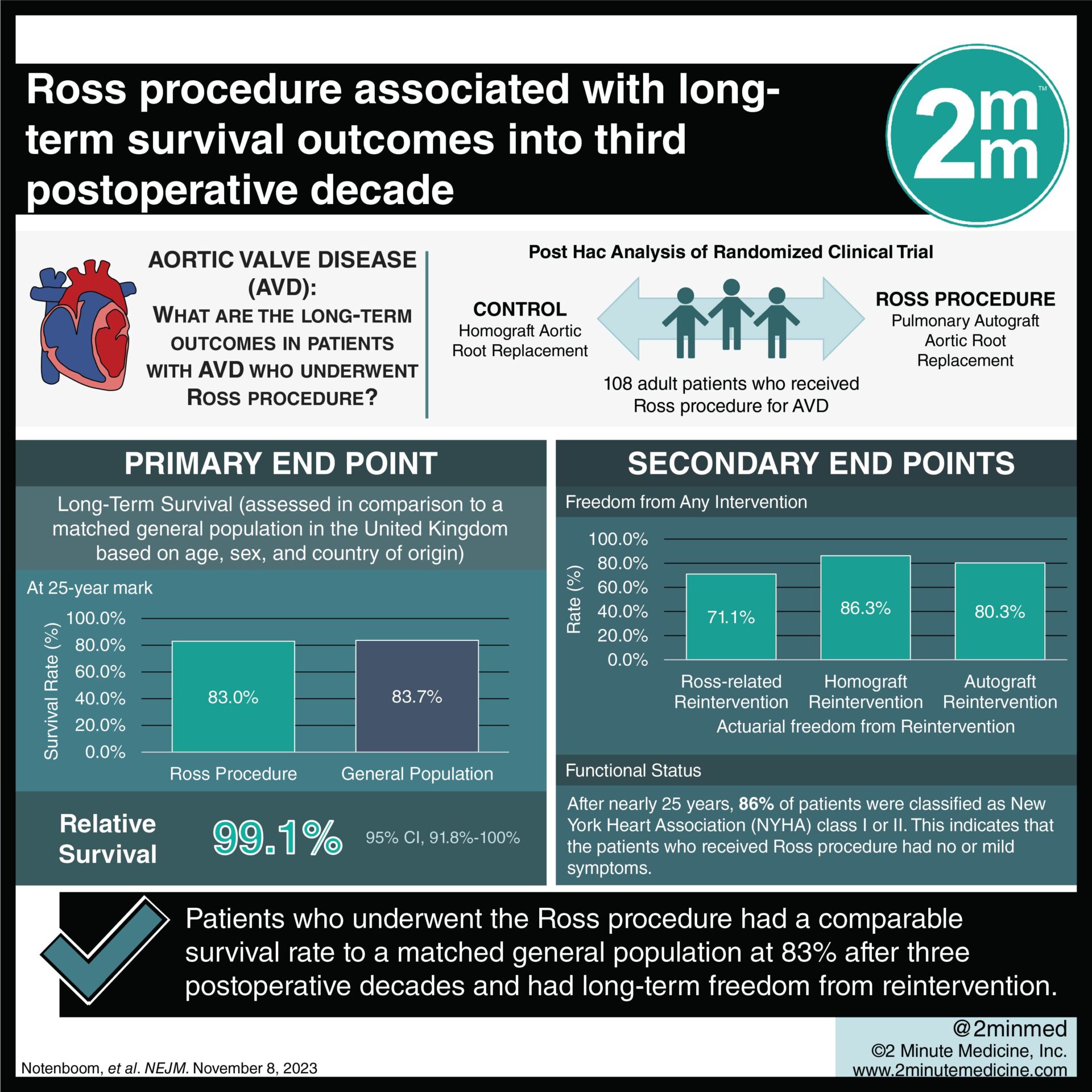1. Patients who underwent the Ross procedure had a comparable survival rate to a matched general population at 83% after three postoperative decades.
2. These patients also showed long-term freedom from reintervention.
Evidence Rating Level: 1 (Excellent)
Study Rundown: The Ross procedure is a surgical technique that uses a pulmonary autograft to treat aortic valve disease (AVD). Recent studies on the Ross procedure show that it provides survival rates similar to the general population, unlike other valve replacements. Although the procedure demonstrates superior outcomes regarding valve-related events, concerns about late complications limit its widespread use. This study evaluated the long-term clinical and echocardiographic results after implementing the Ross procedure in the treatment of adults with AVD. This post hoc analysis of the randomized clinical trial found that the Ross procedure demonstrated excellent long-term survival, comparable to the general population, extending into the third decade postoperatively. The procedure also exhibited enduring efficacy without the need for further interventions, suggesting its durability into late adulthood. One limitation of this study is its reliance on a single-surgeon experience, complicating the generalizability of the results, although advancements in understanding the technical aspects of the Ross procedure have improved reproducibility across specialized centers. In conclusion, these findings additionally reinforce the distinctive advantages of utilizing a living valve replacement in adults, indicating that this positive impact persists throughout the third decade postoperatively.
Click to read the study in JAMA Cardiology
Click to read an accompanying editorial in JAMA Cardiology
Relevant Reading: Ross Procedure Versus Mechanical Versus Bioprosthetic Aortic Valve Replacement: A Network Meta‐Analysis
In-Depth [randomized controlled trial]: This study is a post hoc analysis of a randomized clinical trial comparing homograft root replacement with the Ross procedure conducted between September 1994 and May 2001 at one center in the UK. Patient data from 2010 onwards was retrospectively gathered in November and December of 2022. The current study’s focus was to look at the long-term outcomes of the patients who underwent the Ross procedure and included 108 adult patients. The primary outcome was long-term survival, which was assessed in comparison to a matched general population in the UK based on age, sex, and country of origin. Secondary outcomes included the absence of valve-related reintervention (homograft or autograft) and long-term change of autograft and homograft regurgitation and of autograft dimensional and functional status at the latest follow-up. At the 25-year mark, the survival rate was 83.0% (95% CI, 75.5%-91.2%), with a relative survival of 99.1% (95% CI, 91.8%-100%) compared to an age-, country of origin–, and sex-matched general population, which had a survival rate of 83.7%. After 25 years, the actuarial freedom from any Ross-related reintervention was 71.1% (95% CI, 61.6%-82.0%); from homograft reintervention, 86.3% (95% CI, 79.0%-94.3%); and from autograft reintervention, 80.3% (95% CI, 71.9%-89.6%). During the most recent clinical follow-up, after nearly 25 years, 86% of patients were classified as NYHA class I or II.
©2023 2 Minute Medicine, Inc. All rights reserved. No works may be reproduced without expressed written consent from 2 Minute Medicine, Inc. Inquire about licensing here. No article should be construed as medical advice and is not intended as such by the authors or by 2 Minute Medicine, Inc.










